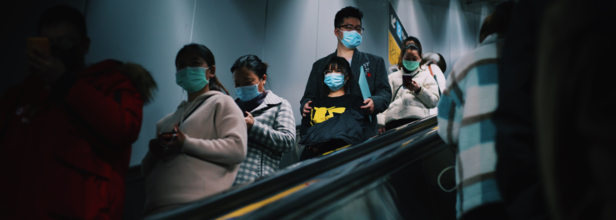- Health Conditions A-Z
- Health & Wellness
- Nutrition
- Fitness
- Health News
- Ayurveda
- Videos
- Medicine A-Z
- Parenting
- Web Stories
Flu Is A Greater Risk This Winter, Not COVID

It has been five years since the first case of COVID-19 was reported in the US, since then it has unleashed winter waves of illness. It is the mutation of the strain, and every winter, there was a new one. However, this winter, COVID seemed much more muted, the hospitalization rates to have gone down. While it is a good news for the people, bad news and diseases have lingered in form of flu.
This winter season walking pneumonia, RSV, norovirus and bird flu, along with influenza grabbed more attention than COVID-19.
Why Are These Diseases or Viruses More Active In Winters?
Winter offers to best condition for airborne viruses to spread because this is the season when people travel the most or gather due to the holidays. People also spend more time indoors, go out in the sun much less. As per Demetre Daskalakis, who directs the Centers for Disease Control and Prevention (CDC)'s response to respiratory infectious-disease threats, "Right now, flu is the driver."
However, it is not easy to compare the previous winter COVID-19 waves with current cases as the data and its collection has changed. Hospitals no longer test every patient for covid, and official tallies are no longer available as more and more people are taking tests at home or not taking the test anymore. However, if one has to compare, it is best to rely on the CDC reports which notes that 38 out of every 100,000 people who were hospitalized this season had COVID-19, as of January 11. This is less than half the rate at the same point last year.
So, what changed this winter?
Unlike flu or RSV, COVID-19 stays even during the spring and in summer, and the COVID-19 wave this summer (2024) was worse than the one in 2023. This is why when winters arrived, it was much weaker, says Jennifer Nuzzo, an epidemiologist and director of the Pandemic Center at the Brown University School of Public Health, reports The Washington Post. “We had such a huge summer wave of infection, and that left in its wake a lot of immunity,” Nuzzo told the news outlet.
What this means is those who were exposed to COVID-19 in summer were less likely to become infected by the virus in the winters. While the virus has mutated, formed new strain, however, it has not evolved drastically.
When someone develops immunity against a virus due to vaccination, the virus then has to evolve to bypass the antibodies trained to block it to keep infecting people. While there has been accounts of the XEC variant, for half of the new cases, it is not necessarily very different from the KP and FLiRT strain.
“We are definitely moving in a very similar axis of viruses where there’s not been like a sudden shift or a change that evades immunity,” Daskalakis told The Washington Post.
However, having said that, it does not necessarily mean that by each winter, the virus will get weaker, because there is a fair chance for the virus to evolve and more threatening variants to emerge. This could affect people because while most Americans got their first COVID-19 shots, they were much less willing to get booster doses.
ByHeart Baby Formula Recalled As 10 US States Report 13 Cases Of Infant Botulism After Use

Credits: Canva
The Centers for Disease Control and Prevention (CDC), US, has issued a statement recalling an organic baby formula. The company ByHeart Inc's two lots of Whole Nutrition Infant Formula has been recalled, the lots are:
- Lot: 206VABP/251261P2 ("Use by 01 Dec 2026")
- Lot: 206VABP/251131P2 ("Use by 01 Dec 2026")
In a statement, the CDC wrote:
CDC and public health officials in several states, the Infant Botulism Treatment and Prevention Program, and FDA are investigating a multistate outbreak of infant botulism linked to recalled infant formula. Infant botulism happens when swallowed spores from a type of bacteria called Clostridium botulinum infects a baby's large intestine and make toxin in it. Infant botulism often starts with constipation but is usually first noticed as difficulty feeding (sucking and swallowing), a weak and altered cry, and loss of muscle tone.
The CDC also notes that 10 states have seen the cases infant botulism. 13 cases have been reported, all of them leading to hospitalization.
The Food and Drug Administration (DA), US has also asked parents and caregivers who have this product to identify the given lot information at the bottom of the packaging and if it matches, they must throw it away. The FDA has said that it is working with retailers to remove "all potentially impacted product" from the store shelves.
FDA has also asked parents who have fed their kids ByHeart's infant formula to keep and eye on them as a precaution and botulism can take two weeks to develop.
The States Which Have Reported The Cases Of Infant Botulism Linked With ByHeart Formula:
- Arizona
- California
- Illinois
- Minnesota
- New Jersey
- Oregon
- Pennsylvania
- Rhode Island
- Texas
- Washington
What Is Infant Botulism?
Most common form of all botulism in babies, who are between 2 to 8 months old. It happens when the bacteria spores grow in a baby’s intestines and produce the toxin. Honey and contaminated soil can be sources of infant botulism. Adults can also get this type, though it’s rare.
What Are The Symptoms Of Botulism In Infants?
As per CDC, the symptoms include:
- Most infants with infant botulism will initially develop constipation, poor feeding, loss of head control, and difficulty swallowing
- If untreated, infants with infant botulism experience a progressive flaccid paralysis that can lead to breathing difficulties and required weeks of hospitalization
The CDC has also recommended that if clinical supports infant botulism then parents and caregivers must begin the treatment and should not wait for laboratory confirmation.
What Did The Makers Of The Infant Formula Say?
ByHeart, which is a New York City based company said that the FDA has as of now tracked 83 reports of infant botulism across the nation since August, 13 of them from the formula. In the statement, the company said: "ByHeart is taking the proactive step to remove any potential risk from the market and ensure the highest level of safety for infants. The FDA has not identified a direct link between any infant formula and these cases and there is no historical precedent of infant formula causing infant botulism."
Mounjaro Becomes India’s Top-Selling Medicine in October; What’s Driving The Surge

Credits: Canva
Eli Lilly’s weight-loss and diabetes injection, Mounjaro, has overtaken GSK’s antibiotic Augmentin (GSK.L) to become India’s highest-selling drug by value in October, as demand for weight-loss treatments continues to surge in the world’s most populated country. According to new data from research firm Pharmarack, the U.S.-based drugmaker’s popular injectable earned ₹1 billion ($11.38 million) in sales last month, compared to Augmentin’s ₹800 million.
While Augmentin still led in overall units sold—5.8 million doses versus 85,000 of Mounjaro—the latter’s premium pricing pushed it ahead in total value, as per Reuters. Analysts say India is rapidly emerging as a major market for obesity treatments, with the global weight-loss drug sector expected to cross $150 billion annually by the end of this decade.
Eli Lilly’s Mounjaro Becomes India’s Top-Selling Medicine in October
Launched in India in March 2025, Mounjaro which helps regulate blood sugar levels and reduces appetite—has seen its sales double within months, surpassing its rival Wegovy by Novo Nordisk, which entered the Indian market in June. Data from Pharmarack shows that Mounjaro has so far generated ₹3.33 billion in total revenue.
“Mounjaro’s consumption in India by volume was nearly ten times higher than Wegovy in October,” said Sheetal Sapale, Vice President (Commercial) at Pharmarack. Eli Lilly sold around 262,000 doses of Mounjaro last month, compared to 26,000 doses of Wegovy. Both drugs belong to the GLP-1 receptor agonist class, designed to treat obesity and type 2 diabetes.
How Does Mounjaro Work?
Mounjaro is a once-weekly injectable medication developed primarily for managing type 2 diabetes. Its key ingredient, tirzepatide, is the first of its kind to act on two gut hormones—GLP-1 (glucagon-like peptide-1) and GIP (glucose-dependent insulinotropic polypeptide). This dual mechanism makes Mounjaro more advanced than older drugs such as Ozempic (semaglutide) or Victoza (liraglutide), which target only GLP-1, which is thus driving a surge in its sale in india.
Although it was originally approved for diabetes management, Mounjaro has attracted global attention for its strong weight-loss effects. Ongoing studies are evaluating its use for non-diabetic individuals struggling with obesity. The drug mimics the action of GIP and GLP-1, which are hormones released naturally after meals to regulate insulin release, lower blood sugar, and suppress appetite.
Mounjaro for Type 2 Diabetes
For people living with type 2 diabetes, keeping blood sugar in check often requires a combination of medicines, diet adjustments, and regular monitoring. Mounjaro offers a more integrated solution by targeting multiple factors that influence glucose levels. Findings from clinical trials, including the SURPASS-1 to SURPASS-5 studies, show that Mounjaro delivers better outcomes than many existing diabetes treatments, particularly in lowering HbA1c levels—a key marker of long-term glucose control.
Patients using Mounjaro have shown:
- Lower fasting and post-meal blood sugar levels
- Reductions in HbA1c by up to 2.5%
- Improved insulin sensitivity
Mounjaro and Weight Loss
Beyond its use for diabetes, Mounjaro has gained global popularity for its significant role in weight reduction. Clinical studies reveal that people taking the drug often lose between 15% and 20% of their body weight over several months of consistent use. This level of weight loss surpasses that seen with many earlier treatments and even some surgical interventions, making Mounjaro one of the most effective options currently available for managing obesity.
Disclaimer: This article is intended for general information and should not replace professional medical guidance. Always consult your doctor for advice or concerns regarding any health condition.
Trump Administration May Deny Visas To Obese, Diabetic Immigrants: What We Know So Far

Credits: CANVA
Following the sharp hike in the H-1B visa fee to $100,000, the Trump administration may soon begin rejecting visa applications from foreigners with certain health conditions, including diabetes and obesity.
While there has been no formal confirmation from U.S. authorities, a report by KFF Health News said a cable from the State Department to embassies and consulates listed new health-related grounds for visa denials.
Trump May Now Deny Entry to Diabetic and Obese Immigrants
According to the report, the guidance instructs visa officers to consider applicants ineligible for entry based on factors such as age and medical conditions, including cardiovascular and respiratory diseases, cancer, diabetes, metabolic and neurological disorders, and certain mental health conditions.
Officers have also been told to evaluate other issues such as obesity — which can contribute to high blood pressure, asthma, and sleep apnea, when assessing whether an applicant might become a “public charge,” or a potential financial burden on the U.S. government.
The guidance further directs officials to determine whether the applicant has sufficient financial resources to pay for their care. “Does the applicant have adequate financial resources to cover the costs of such care over his entire expected lifespan without seeking public cash assistance or long-term institutionalization at government expense?” the cable states.
It adds that individuals who could become a “public charge” — due to age or chronic health problems, may be denied entry for potentially relying on U.S. public resources.
Although the directive applies broadly to most visa categories, it is expected to primarily impact those applying for permanent residency, senior attorney Charles Wheeler told KFF Health News.
Can US Officers Reject Visas Over Health Or Financial Ability?
Visa officers have also been instructed to evaluate whether applicants can afford medical treatment independently, without relying on U.S. public funds.
Wheeler said the new rule gives officers the power to form their own opinions on what might lead to future medical emergencies or financial strain. “That’s concerning because these officers are not medically trained, have no expertise in this area, and should not be making projections based on personal judgment or bias,” Wheeler said.
US Visa Officers To Consider Health Of Applicants’ Family Members
The cable also instructs visa officers to assess the health of applicants’ family members — including children or elderly parents, when determining visa eligibility.
“Do any of the dependents have disabilities, chronic medical conditions, or other special needs and require care such that the applicant cannot maintain employment?” the State Department communication asks.
Currently, immigrant applicants must undergo a medical examination conducted by a doctor approved by the U.S. embassy. The screening includes tests for infectious diseases, an evaluation of mental health history, substance use, and proof of vaccination against illnesses such as measles, polio, and hepatitis B.
However, immigration lawyer Sophia Genovese from Georgetown University noted that the new guidance expands these requirements by directing officials to weigh long-term health conditions, not just communicable diseases, when reviewing visa applications.
© 2024 Bennett, Coleman & Company Limited

